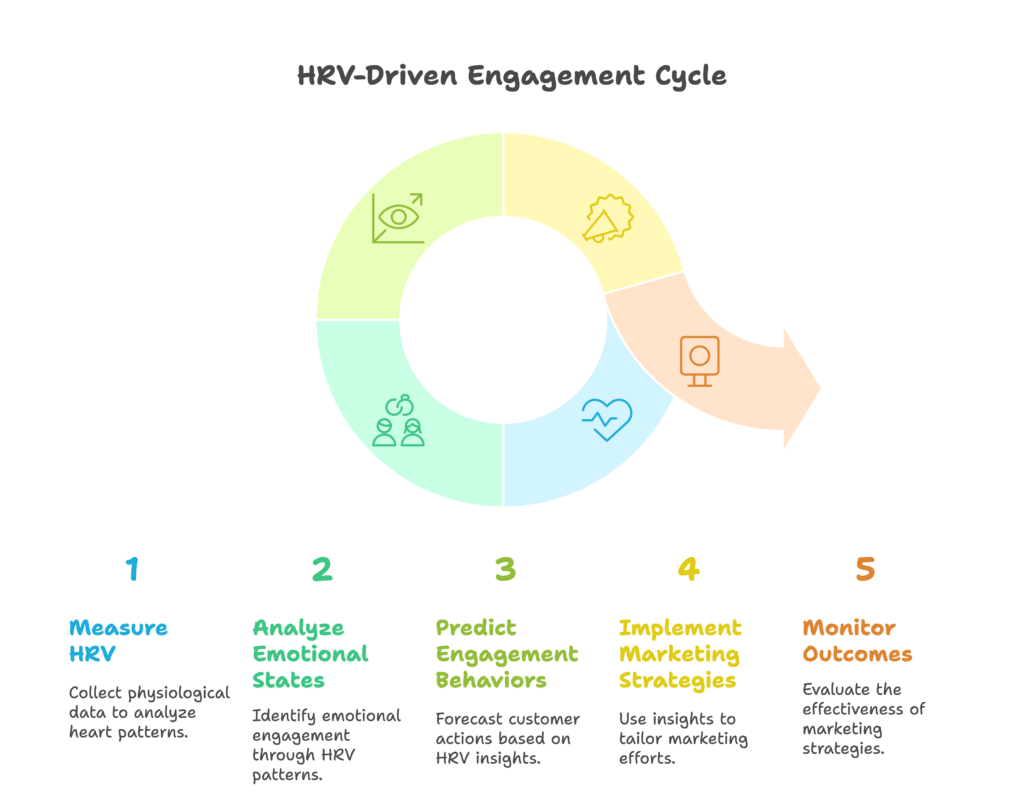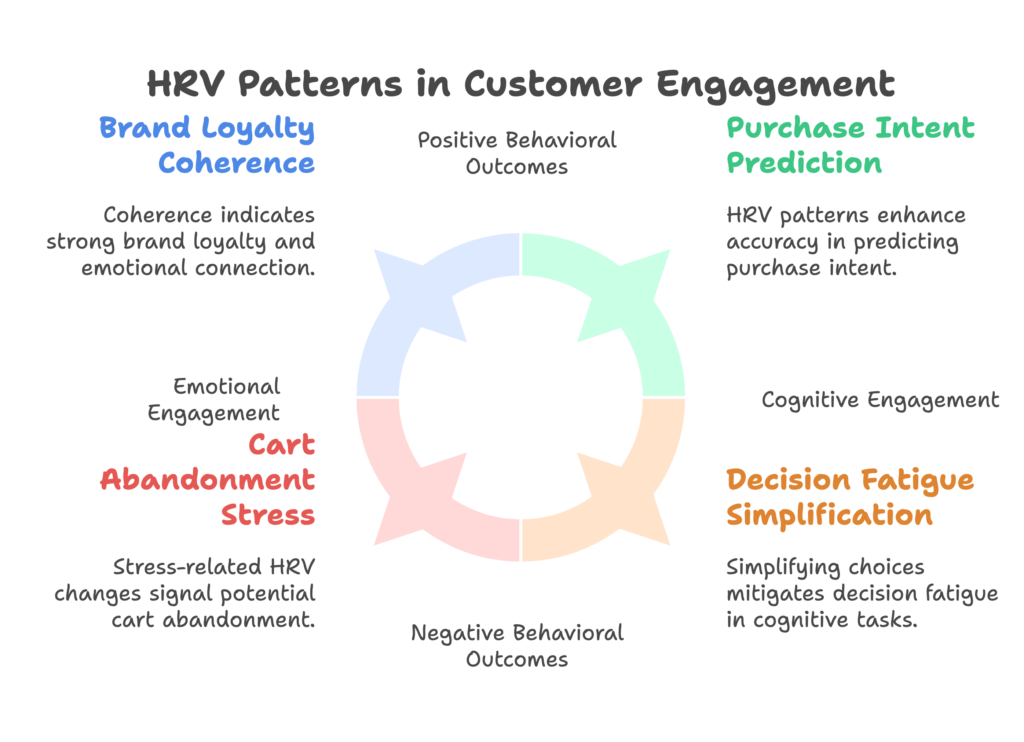Have you ever wondered why some marketing campaigns make your heart race while others barely register a blip on your emotional radar? What if I told you that the actual beating of your heart could predict how you’ll engage with brands and products?
Welcome to the fascinating intersection of neuroscience and marketing, where your heart’s rhythm might be the most honest feedback you’ll ever give to marketers. The tiny variations in time between your heartbeats—known as Heart Rate Variability (HRV)—could be the key to understanding what truly engages customers.
By reading this article, you’ll discover:
- How your nervous system responds to marketing without your conscious awareness
- Why HRV is a powerful predictor of customer engagement
- How brands are already using this science to create more effective marketing
- Practical ways this emerging field can transform customer experiences
Ready to explore how your heartbeat might be revealing your next purchase decision? Let’s dive in!
Neurophysiological Foundations of HRV
Before we can understand how heart rhythms predict customer behavior, we need to explore what’s happening beneath the surface in our bodies. This foundation will help you see why HRV isn’t just another marketing buzzword—it’s rooted in real human biology.

Autonomic Nervous System Dynamics
Your body has an incredible autopilot system called the Autonomic Nervous System (ANS) that controls unconscious functions like breathing, digestion, and—you guessed it—your heartbeat. This system has two main branches working in a delicate balance:
- Sympathetic nervous system – Your “gas pedal” that activates during stress, excitement, or danger (think “fight or flight”)
- Parasympathetic nervous system – Your “brake pedal” that promotes calm, recovery, and relaxation (think “rest and digest”)
When these systems are in perfect harmony, your heart doesn’t beat like a metronome—it naturally varies with each beat. Higher variability (larger gaps between beats) typically indicates a well-functioning nervous system that can adapt quickly to different situations. Lower variability often suggests stress or overwhelm.
This variability evolved for a good reason: our ancestors needed rapid heart rate changes to sprint away from predators one moment and calmly forage for food the next. Interestingly, the same system that helped us survive in the wild now responds to marketing emails and social media ads!
Neural Correlates of Customer Engagement
When you engage with a brand, your brain goes through a complex dance of activation. Brain regions like the prefrontal cortex light up during decision-making processes, while the amygdala—your emotional center—responds to marketing stimuli that trigger feelings.
These neural activities directly influence your ANS and, consequently, your heart rhythm. When you see a product that excites you, dopamine (the “reward” neurotransmitter) is released, creating a cascade of physiological responses that can be measured through HRV.
For example, when you’re genuinely interested in a product, your brain enters a state of focused attention, creating a distinctive HRV pattern that’s quite different from when you’re bored or anxious about a purchase.
HRV Measurement Methodologies
Measuring these tiny variations between heartbeats has become increasingly accessible thanks to modern technology. There are several ways to capture HRV data:
- ECG (Electrocardiogram) – Uses electrical sensors on the skin for highly accurate readings
- PPG (Photoplethysmography) – Uses light sensors found in most smartwatches and fitness trackers
- Specialized HRV apps – Work with existing wearable devices to track heart rhythm patterns
The duration of measurement matters too. Some insights require 24-hour monitoring, while others can be gathered from brief “spot checks” during specific customer interactions. Advanced machine learning algorithms can now recognize patterns in this data that would be invisible to the human eye.
With our biological foundation in place, you might be wondering: “How exactly does my heart rhythm connect to whether I’ll click ‘buy now’ or abandon my cart?” Great question! Let’s explore how HRV directly predicts different types of customer engagement.
HRV as an Engagement Predictor
Now that you understand the science behind heart rate variability, let’s explore how these heartbeat patterns can predict how customers will engage with brands. These insights go far beyond what traditional surveys or click data can tell us.

Emotional Engagement Signatures
Your emotions leave distinct fingerprints in your heart rhythm. Research shows that positive emotional states typically correspond with higher HRV, while stress and negative emotions often reduce HRV. This creates recognizable patterns that correlate with how customers feel about brands.
Interestingly, researchers have identified specific HRV patterns that occur just before someone abandons their online shopping cart. The physiological stress response that happens when prices seem too high or shipping costs appear unexpectedly can be detected through HRV changes before the customer consciously decides to leave.
Some advanced marketing teams even measure what’s called “coherence”—a state where heart rhythm becomes exceptionally ordered. This state often correlates with deep brand attachment and loyalty. When customers experience coherence while interacting with brand content, they’re much more likely to develop long-term loyalty.
Cognitive Engagement Markers
It’s not just emotions—your thinking processes affect your heart too. When you’re mentally engaged with content, your HRV displays recognizable patterns that differ from when you’re cognitively disengaged or overwhelmed.
For example, when a customer is comparing product options, their working memory gets loaded with information. HRV can indicate when someone reaches their cognitive threshold—the point where too much information becomes overwhelming rather than helpful. Smart marketers use these insights to simplify product pages and checkout processes.
HRV patterns can also reveal decision fatigue—the mental exhaustion that happens after making too many choices. This often occurs late in the shopping journey and can be addressed by reducing unnecessary decision points.
Behavioral Engagement Correlates
Perhaps most valuable to marketers, HRV patterns have been shown to predict actual customer behaviors:
- Purchase intent can be predicted with surprising accuracy based on HRV responses to product images or descriptions
- The likelihood of social sharing increases when parasympathetic nervous system activation occurs during content consumption
- Participation in loyalty programs correlates with specific neural and HRV markers during program introduction
By monitoring these physiological responses, marketers can forecast behaviors that customers themselves might not even be consciously aware they’ll take.
These predictive capabilities sound powerful, but you might be wondering: “How do companies actually collect and use this kind of data?” That’s an excellent question—let’s look at the practical implementation next.
Measurement & Implementation Framework
Understanding HRV is one thing, but putting it into practice is another challenge entirely. This section breaks down how organizations can actually collect, analyze, and act on heart rate data to improve customer engagement.
Data Collection Protocols
Gathering quality HRV data requires thoughtful planning. Companies typically follow these steps:
- Select appropriate measurement devices – ECG devices provide higher accuracy but are more intrusive, while PPG sensors (found in smartwatches) offer convenience at slightly lower precision
- Identify key customer touchpoints for measurement – These might include initial website visits, pricing page views, checkout processes, or post-purchase communications
- Develop ethical consent frameworks – Transparent opt-in processes are essential, with clear explanations of what data is collected and how it will be used
Research panels often provide the most controlled environment for collecting this data. Participants knowingly wear HRV monitoring devices while interacting with marketing materials, providing invaluable insights without the ethical concerns of covert monitoring.
HRV Analytics Pipeline
Once collected, HRV data needs sophisticated processing to yield actionable insights:
- Real-time emotional state classification – Algorithms can categorize customer emotional states (interested, confused, frustrated, excited) based on HRV patterns
- Longitudinal engagement trend analysis – Tracking how engagement changes over time across different marketing campaigns or product iterations
- Cross-channel coherence scoring – Measuring whether engagement remains consistent across website, email, social media, and other touchpoints
The most effective systems combine HRV data with traditional metrics like click rates and conversion data, creating a more complete picture of customer engagement.
Personalization Strategies
The ultimate goal is using HRV insights to deliver more engaging experiences:
- Content adaptation systems that modify messaging based on detected emotional states
- Optimal timing algorithms that identify when customers are most receptive to communications
- Interface modifications that simplify experiences when cognitive overload is detected
For example, if HRV data suggests a customer is experiencing stress during checkout, a system might automatically offer simplified payment options or reassuring security information.
Now that we understand how to implement HRV tracking, you’re probably curious about specific ways marketers are using these insights. Let’s explore some strategic applications that are changing how brands connect with customers.
Strategic Applications in Marketing
This is where theory meets practice—how are forward-thinking marketers actually using HRV insights to create more effective campaigns and experiences? These applications show the real-world impact of heart-based metrics.
Campaign Optimization
Creative testing has been revolutionized by HRV analysis. Rather than relying solely on self-reported feedback (which is often inaccurate), marketers can measure authentic physiological responses to different marketing materials:
- Different ad visuals can be evaluated based on their HRV impact, revealing which truly resonates emotionally
- Message framing can be tailored to match the autonomic state of target audiences
- Multisensory marketing elements (sound, color, motion) can be calibrated to create optimal engagement
One retail brand discovered that product videos with a specific pacing created 37% higher engagement (as measured by HRV) than their standard format, leading to a complete revision of their creative guidelines.
Customer Journey Engineering
The customer journey can be redesigned to reduce stress and enhance positive engagement:
- Onboarding stress reduction – Simplifying initial interactions based on HRV feedback that identifies confusing or overwhelming elements
- Checkout flow management – Redesigning the purchase process to maintain optimal cognitive load (not too boring, not too complex)
- Post-purchase interventions – Creating communications that address the specific emotional states detected after purchase (excitement, anxiety, etc.)
One e-commerce company found that introducing a progress indicator during checkout reduced stress-related HRV patterns by 23%, directly increasing completion rates.
Loyalty Program Design
Perhaps most valuable for long-term business growth, HRV insights are reshaping how companies build loyalty:
- Reward system neurovalidation – Testing which rewards create genuine positive emotional responses versus merely practical consideration
- Community engagement biomarkers – Identifying which community interactions create the deepest sense of belonging and connection
- Churn prediction models – Using early HRV warning signs to identify customers at risk of leaving before traditional metrics would detect them
A subscription service company discovered that surprising gifts created significantly higher positive HRV responses than predictable discount offers of equivalent value, leading them to redesign their entire loyalty strategy.
These applications sound impressive in theory, but do they deliver results in the real world? Let’s look at some fascinating case studies that demonstrate the power of HRV-driven engagement.
Case Studies in HRV-Driven Engagement
Theory is valuable, but nothing demonstrates the power of HRV like seeing it in action. These real-world examples show how organizations are using heart rhythm insights to transform their marketing results.
Honda HR-V Campaign Success
In a delightful case of name synchronicity, Honda’s HR-V vehicle campaign provides a perfect example of HRV application. The auto manufacturer used HRV monitoring to test driver reactions to different advertising concepts.
The research team discovered that ads focusing on the vehicle’s versatility created significantly stronger positive HRV responses than those highlighting fuel efficiency, despite focus groups suggesting the opposite. When Honda adjusted their creative strategy accordingly:
- Brand lift metrics increased by 26% compared to previous campaigns
- Organic search for the HR-V model increased by 18%
- Test drive appointments showed a 22% improvement
This neurological approach helped Honda align their messaging with what truly resonated emotionally with potential buyers, rather than what customers thought they should care about.
Healthcare Marketing Breakthroughs
The healthcare sector has found particularly valuable applications for HRV insights:
A pharmaceutical company used HRV monitoring to study how patients responded to different medication adherence messages. They discovered that communications emphasizing progress and achievement created more positive emotional states than those focusing on health risks.
The revised communication strategy led to:
- 27% improvement in medication adherence rates
- Significantly reduced stress responses during reminder notifications
- More positive patient-reported experiences with the brand
Another healthcare provider used HRV insights to develop content specifically designed to reduce stress levels for patients with chronic conditions. The resulting engagement program showed measurable improvements in both patient outcomes and satisfaction scores.
E-commerce Personalization
Online retailers have discovered particularly powerful applications of HRV insights:
One major e-commerce platform conducted research to identify the HRV patterns associated with pricing stress—the uncomfortable reaction customers have when prices feel too high. They discovered that each customer segment had different thresholds, allowing for more personalized pricing strategies.
Another online retailer developed a system to detect the specific HRV signature that preceded cart abandonment. This allowed them to trigger targeted interventions (like well-timed chat support or tailored offers) before the customer left. The result was a 17% reduction in abandonment rates.
Perhaps most innovatively, a subscription service used HRV data to create “neurosegmentation” for their loyalty program. Rather than using traditional demographics, they grouped customers based on their emotional response patterns, creating more engaging experiences for each neurological profile.
These examples show impressive results, but you might be concerned about the ethical implications of measuring something as personal as heart rhythms. You’re right to be cautious—let’s explore the ethical guidelines that should govern this powerful approach.
Ethical Implementation Guidelines
With great power comes great responsibility. As HRV measurement becomes more accessible, establishing clear ethical boundaries is essential. This section outlines how organizations can use this technology responsibly while respecting customer autonomy and wellbeing.
Privacy & Consent Management
Biometric data like HRV requires the highest standards of privacy protection:
- GDPR-compliant data handling – In many regions, HRV data qualifies as health information requiring explicit consent and strict protection
- Transparent value exchange – Clearly explaining to customers what benefits they receive in exchange for sharing this data
- Anonymization protocols – Converting individual data into group-level insights whenever possible
Best practices include obtaining explicit, informed consent that can be easily withdrawn, storing data securely with strict access controls, and regularly deleting raw data when it’s no longer needed.
Vulnerability Protections
Ethical marketers must establish safeguards to protect vulnerable customers:
- Cognitive overload prevention – Systems should detect when customers are experiencing overwhelming stress and simplify experiences accordingly
- Addiction pattern monitoring – Especially important for gaming, social media, and e-commerce platforms to avoid exploiting unhealthy engagement patterns
- Financial stress detection – Ethical systems should recognize and respond appropriately to signs of financial anxiety
One forward-thinking financial services company uses HRV insights to identify when customers show stress patterns during loan applications and automatically offers additional support resources rather than pushing for completion.
Cultural Adaptation
HRV patterns aren’t universal—they vary across cultures and populations:
- Cross-cultural calibration – Baseline HRV measurements differ across cultural groups and require calibrated interpretation
- Localized threshold setting – Engagement markers should be adjusted based on cultural norms around emotional expression
- Ethical review boards – Diverse perspectives should evaluate neuromarketing applications before implementation
Organizations working globally must invest in understanding how HRV patterns and their meaning vary across different cultural contexts, avoiding one-size-fits-all interpretations.
With ethical guidelines established, let’s look toward the horizon. What does the future hold for HRV in marketing and customer engagement? The innovations ahead are both exciting and transformative.
Future Directions & Innovations
The intersection of HRV and customer engagement is still in its early stages. Let’s explore the emerging technologies, predictive systems, and theoretical advances that will shape this field in the coming years.
Emerging Technologies
Several technological innovations are set to transform how we use HRV data:
- AI-driven real-time adaptation – Systems that can modify digital experiences in the moment based on detected HRV patterns
- Blockchain-verified emotional authenticity – Using distributed ledger technology to give customers control over their biometric data while verifying its authenticity for marketers
- Metaverse engagement mapping – Extending HRV monitoring into virtual environments to create emotionally responsive virtual spaces
Imagine walking into a virtual store where the lighting, music, and even product selection adjusts in real-time based on your emotional state as measured through your smart device. This level of personalization is becoming increasingly possible.
Predictive Systems
The predictive power of HRV data is expanding into new territories:
- Lifetime value forecasting – Using early HRV response patterns to predict customer lifetime value with remarkable accuracy
- Engagement climate tracking – Monitoring aggregate HRV trends across customer segments to detect market-wide shifts in engagement before they show up in traditional metrics
- Crisis response modeling – Developing systems that can predict and mitigate negative engagement during brand crises
These systems promise to move marketing from reactive to genuinely proactive, addressing engagement challenges before they fully materialize.
Theoretical Advancements
At the cutting edge, researchers are exploring some fascinating theoretical frontiers:
- Quantum biometric processing – Applying quantum computing approaches to process complex HRV patterns at unprecedented scale and speed
- Cross-species engagement comparisons – Understanding universal engagement principles by studying HRV across different species’ interactions with stimuli
- Epigenetic engagement predisposition – Exploring how genetic factors might influence baseline HRV patterns and engagement tendencies
While some of these concepts might sound like science fiction, they represent the leading edge of research that could transform our understanding of customer engagement in the next decade.
As these innovations develop, the marketing landscape will increasingly be shaped by those who understand the profound connection between heart rhythms and customer behavior. The companies that master this connection will create experiences that resonate on a deeper, more authentic level.
Conclusion
We’ve journeyed from the biological foundations of HRV through its practical applications in marketing and into the exciting future that lies ahead. What began as a medical measurement has evolved into a powerful window into customer engagement, offering insights that go far beyond what traditional metrics can reveal.
By understanding the subtle variations in our customers’ heart rhythms, we can create more engaging, less stressful, and ultimately more effective marketing experiences. The brands that embrace these biological insights will build deeper connections with their audiences, creating experiences that truly resonate on a physiological level.
As you consider implementing these approaches in your own marketing strategy, remember that the goal isn’t manipulation but alignment—creating experiences that genuinely engage customers by addressing their needs and reducing unnecessary friction.
Looking to boost your Shopify store’s engagement and sales? Growth Suite offers cutting-edge tools to help you implement many of the strategies discussed in this article, without requiring specialized HRV equipment. Explore how data-driven engagement insights can transform your customer experience and drive sustainable growth.
References
- FasterCapital. (2024). Heart Rate Variability in Marketing Strategies. https://fastercapital.com/content/Heart-rate-variability–Heart-Rate-Variability–A-Key-Metric-for-Effective-Marketing-Strategies.html
- Rybanská, J. et al. (2016). The use of HRV analysis in marketing research. Semantic Scholar. https://pdfs.semanticscholar.org/dd7a/0c723b6a7fca8d40deb2919140a219eda4de.pdf
- PMC. (2024). Heart Rate Variability and Cognition Review. https://pmc.ncbi.nlm.nih.gov/articles/PMC10780278/
- JMIR. (2020). HRV Measurement in Free-Living Conditions. https://biomedeng.jmir.org/2020/1/e17355/
- PMC. (2015). Biometric Security Using HRV. https://pmc.ncbi.nlm.nih.gov/articles/PMC4541821/
- Hoppier. (2024). Customer Engagement Strategies. https://www.hoppier.com/blog/customer-engagement-marketing-strategies
- Nature. (2024). HRV and Positive Affect. https://www.nature.com/articles/s41598-024-57279-5
- PMC. (2023). Smart Wearable HRV Devices. https://pmc.ncbi.nlm.nih.gov/articles/PMC10742885/



